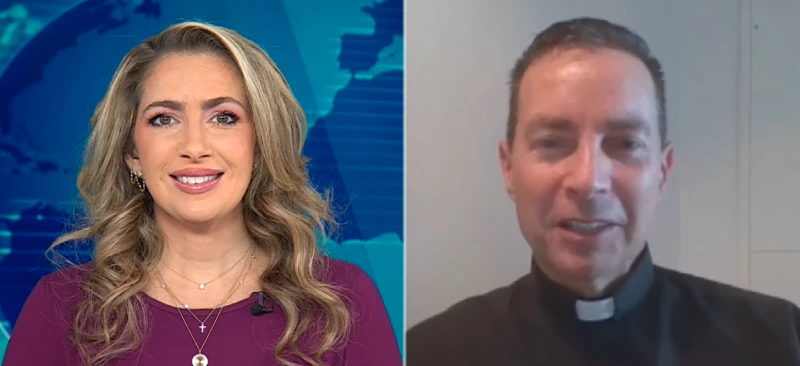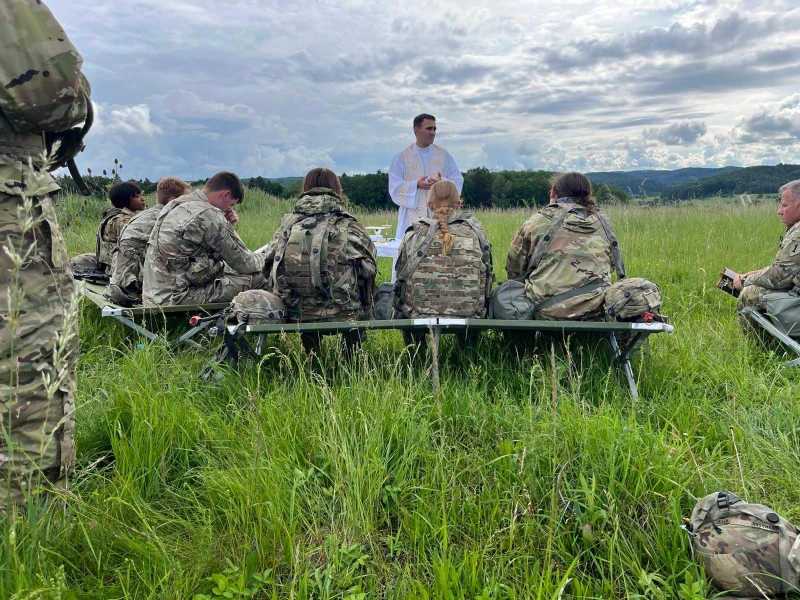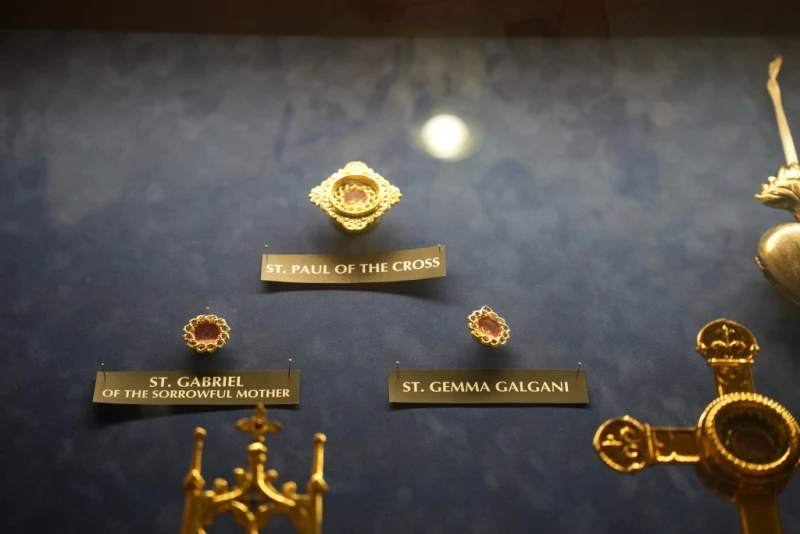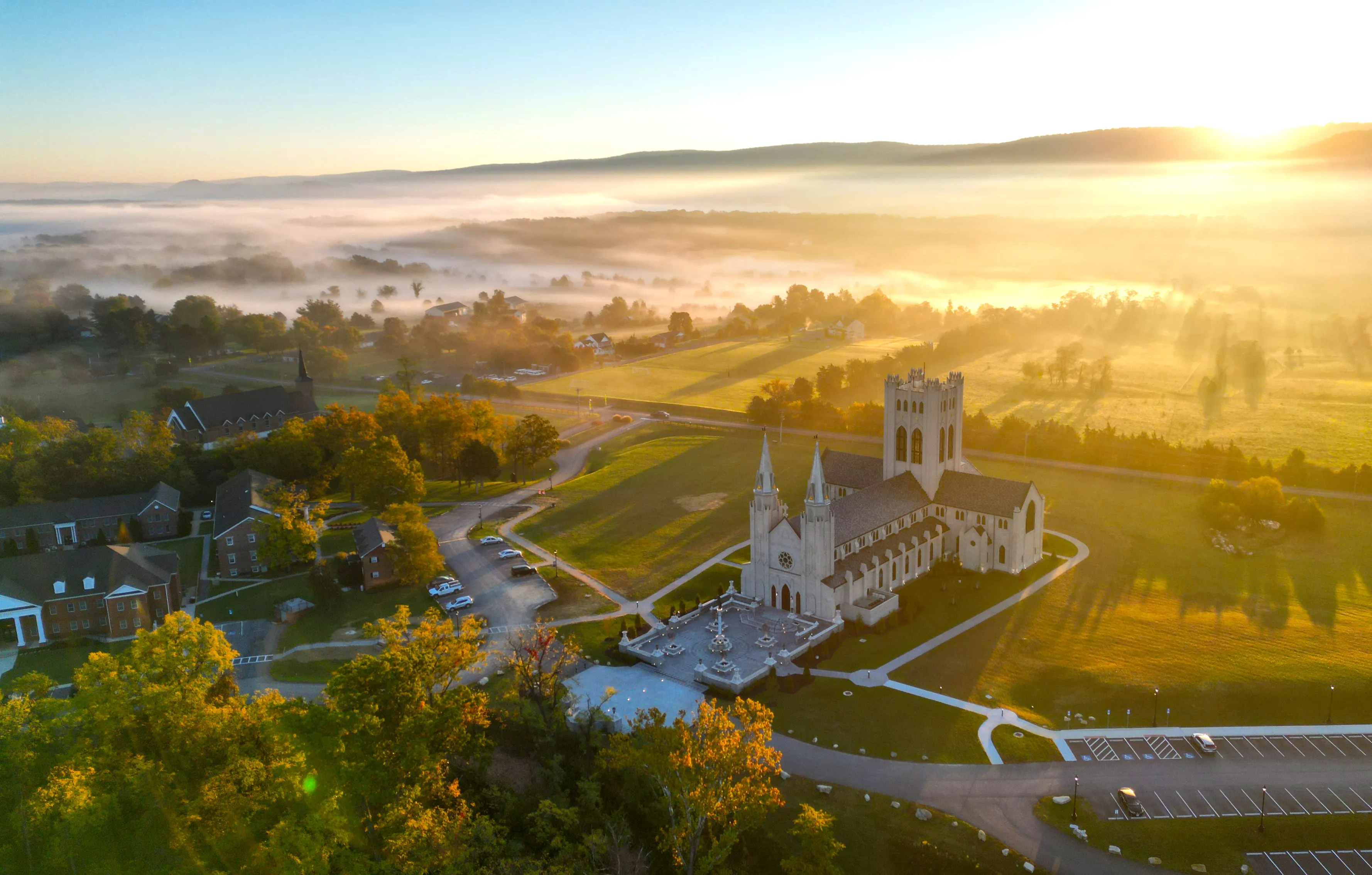

Father Burke Masters speaks to Veronica Dudo on "EWTN News Nightly" on Friday, Oct. 24, 2025 / Credit: EWTN News
Washington, D.C. Newsroom, Oct 25, 2025 / 07:00 am (CNA).
Father Burke Masters’ first dream was to be a major league baseball player, but after feeling a call from God to the priesthood he now uses the sport “to speak about Jesus and the Church.”
“I played college baseball at Mississippi State University, and then played briefly in the minor leagues,” Masters said. “That was my dream to be a major league baseball player, but that didn’t work out.”
“God eventually called me to be a priest,” Masters said in an Oct. 24 interview with “EWTN News Nightly.” He added: “It really wasn’t what I wanted, but it was this persistent and gentle call from the Lord.”
“I went to seminary fully thinking I would go … not like it, and then go back to my plans,” Masters said. “Yet when I got to seminary I just felt this overwhelming peace, and that’s one of the fruits of the Holy Spirit.”
Masters was ordained in 2002, serving as priest in Illinois. Eventually though, baseball did become a part of his career when he was named the chaplain of the Chicago Cubs in 2013.
“God brought baseball back into my life in a way that I never expected,” Masters said. “Since then, people have called me the ‘baseball priest,’ because I love to connect faith with sports.”
While Masters’ “full-time job” was as a pastor in the Diocese of Joliet, he attended all the Cubs’ home games. As the “baseball priest,” Masters was chaplain when they won the World Series in 2016.
“One of my big messages to the players then and to the players now would be: ‘Just remember your identity, you’re beloved sons of God. Your identity is not in the sport of baseball.’ And what I find that helps players … relax to say: ‘Yes, this is a big game. Millions of people are watching, but in the end, it’s still just a game. And life goes on,’” he said.
Connecting faith and sports
In 2023, Masters published a book, “A Grand Slam for God: A Journey from Baseball Star to Catholic Priest.” He wrote about his childhood outside of Chicago, his success in baseball, his conversion to Catholicism, and his acceptance of his vocation.
His story discusses his doubts and personal loss, and how he learned to embrace his identity not as an athlete but as a son of God and spiritual leader.
“Baseball taught me a lot of things, among them, discipline, hard work, and how to work with people of a lot of different backgrounds,” Masters said. “I find that to be so helpful in my life as a priest, as a vocation director, as a pastor, that I try to invest a lot of time in my spiritual life.”
“Also, baseball has given me a way to … reach people who are not close to God at the moment by bringing stories about baseball and my sports background,” Masters said. “It gives me an opening to speak about Jesus and the Church. It’s just been a great gift.”
In homilies, Masters said he will “bring up the sport of baseball.” He added: “I can see some of the people who love the sport perk up and then can bring the Gospel message to them more easily.”
Ahead of the 2025 World Series on Oct. 24, Masters shared with EWTN his predictions for the outcome. He said: “If I go off my head, the Dodgers will win, but I love pulling for the underdog. So my heart is going with the Toronto Blue Jays.”
Read More








![New Catholic app hopes to ‘relight the hope of Catholic dating’ #Catholic
Daniël Hussem and Emily Wilson-Hussem are the creators of the new Catholic dating app, SacredSpark. / Credit: Photo courtesy of Daniël Hussem and Emily Wilson-Hussem
CNA Staff, Oct 9, 2025 / 07:10 am (CNA).
When Emily Wilson-Hussem began sharing “matchmaking” posts on Instagram, inviting Catholic singles to share their names and locations to connect with others, she wasn’t expecting that her lighthearted experiment would lead to 12 marriages, 20 engagements, hundreds of dating couples, and even a baby.The Catholic speaker and digital content creator realized that young Catholics are in search of holy marriages but need help finding one another. This led her and her husband, Daniël Hussem, to create a new Catholic dating app — SacredSpark.The new matchmaking app blends technology and tradition to foster meaningful online connections with the goal of creating lasting offline relationships.“Over these years I have seen the difficulty singles [have] to connect with one another, especially of the same age, and a lot of the young single Catholics I met were having a really hard time, and so I felt like a nudge from the Lord,” Wilson-Hussem told CNA.After seeing the immense response from young people on her matchmaking posts, yet realizing the downfalls of trying to help connect people on Instagram, the Hussems decided to create an app that was intentional and focused on the fact that each user was made in the image and likeness of God.SacredSpark is a Catholic dating and matchmaking app that is blending technology and tradition to foster meaningful online connections with the goal of creating lasting offline relationships. Credit: SacredSparkOne of the main features of SacredSpark is its commitment to more meaningful connections between people. To foster that, all profile pictures are blurred. Photos become unblurred once both individuals match with one another. So instead of simply swiping through images of a person, users can record audio messages introducing themselves and other users can listen and determine if they believe there could be a connection.Hussem explained that this feature was created “because we want to start meaningful connections beyond just the appearance.”The couple also pointed out that unlike other dating apps that allow users to place filters on things like physical traits, including eye color, hair color, or even height, SacredSpark does not allow for any filters to be placed on physical qualities.“For us, we want it to be extremely intentional about the person as a whole, not just their physical appearance,” Hussem shared. “If you’re looking at the general scope of a sacramental marriage, are those things — someone’s color of their eyes or the color of their hair or their height — I think those are more superficial things that people can get sidetracked by versus just these intentional things.”“Our focus is on the image and likeness of God in each person you will connect with on the app. That’s a huge part of the core of what we’re doing,” Wilson-Hussem added.The app also includes a matchmaking feature, which allows the user to invite a friend or family member to act as a matchmaker on their behalf on the app. Wilson-Hussem explained that this feature was added into the app because of the great success matchmakers had on her Instagram posts. “A huge part of the success was a girl saying, ‘I have a brother, Jeff. He’s 31 and he lives in Wisconsin. If there are any great gals out there, I would love to connect you,’” she shared. “I would say at least half of the marriages have been from one person who put one person out there and was linking two other people and we thought, ‘Wow. A, that’s amazing because a lot of people know single Catholics, they have fun with it, but B, our singles need support. They need to feel like people are in their corner.’”She added: “You can hire a matchmaker for thousands of dollars — a person who has to get to know you, a person who has to look at who you are on paper. The people who have known you your whole life know you best. They know what you’re looking for. So, why don’t we find a way to activate those people and support our singles?”SacredSpark will be launched and open to the public in mid-October, but interested singles can already sign up to join the waitlist. The Hussems said they hope the new app will “relight the hope of Catholic dating.”“The overall mission is actually to help build up the Church one relationship at a time,” Daniël Hussem said.“I think a big part of the cultural breakdown is the breakdown of the family, and we want SacredSpark to really be a place, down the road, where we can connect people who will build up the Church because they’ve entered into a sacramental marriage and will build up the family,” Wilson-Hussem added. “The restoration of the family is going to be a huge part of the next many years and we think SacredSpark, hopefully, will play a part in that.”](https://unitedyam.com/wp-content/uploads/2025/10/new-catholic-app-hopes-to-relight-the-hope-of-catholic-dating-catholic-daniel-hussem-and-emily-wilson-hussem-are-the-creators-of-the-new-catholic-dating-app-sacredspark-cred.webp)



















